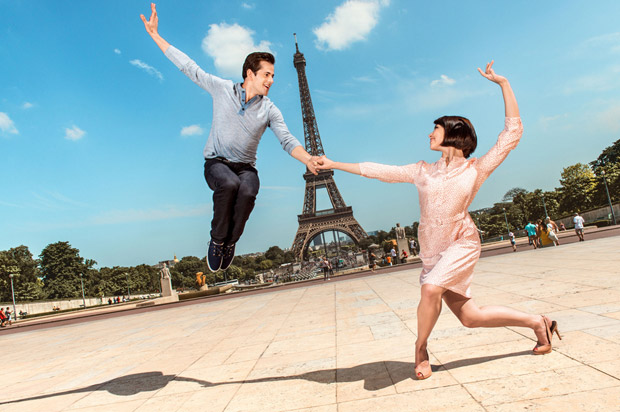
© Angela Sterling. (Click image for larger version)
After its premiere in Paris last autumn, Christopher Wheeldon’s An American in Paris is about to open in New York. Marina Harss talks to Wheeldon and the 2 stars of the show – Leanne Cope and Robert Fairchild
www.anamericaninparisbroadway.com
“This is Paris,” says the genial voice of Gene Kelly at the start of the 1951 movie An American in Paris. Images of the Place de la Concorde, the Opéra and the Île de la Cité fly by. “I’m an American who lives here. My name, Jerry Mulligan; I’m an ex-GI…. I’m a painter. All my life, that’s all I’ve ever wanted to do.” The sparkling fountains and squares of Paris are bathed in unconvincing, but no less enticing candy-colored skies. In the Paris of American movie musicals, the sun is always shining.
Sixty-four years later, American in Paris is coming to Broadway. Oddly, Vincente Minnelli’s reverie on romance, art and American bluster has never made it to the stage. This despite a bevy of Gershwin tunes that just beg to be danced to. The show’s producers made the canny choice of handing the stage adaptation to someone who could capitalize on the music, a choreographer rather than a man of the theatre. Because the score includes an actual ballet, this person had to have a more than glancing acquaintance with the danse d’école.
They set their sights on the young Briton, Christopher Wheeldon, a product of the Royal Ballet School, onetime artist-in-residence at New York City Ballet, and now globe-trotting guest choreographer, responsible for such large-scale works as Alice’s Adventures in Wonderland and A Winter’s Tale. It took eight months to convince him, but finally he said yes. “I was so nervous,” the trim, handsome Wheeldon told me over a diet coke at Café Un Deux Trois, “as if I were jumping into something I had no right to be taking on.”
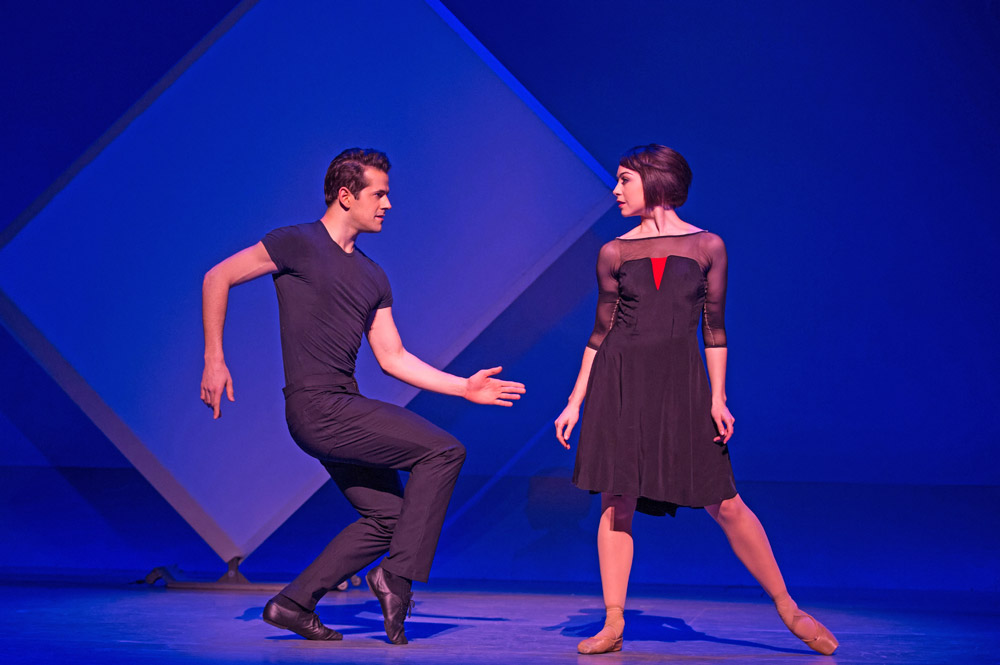
© Matthew Murphy. (Click image for larger version)
How does the show differ from the movie? There’s less talking and more music, for one. The Gershwin estate allowed Wheeldon to use extra songs to tell his story. There are also little tweaks to the setting and the characters. Lise, the object of Mulligan’s affections, is depicted as both an aspiring ballerina – she was a simple shop-girl in the movie – and a Jew, whose parents have disappeared into the black hole of the war. The war is a still-fresh wound: Jerry mentions traumatic experiences, his friend Adam has a limp, Lise’s relationship to her Parisian admirer, Henri, is inextricably bound up with her gratitude for his family’s protection.
But beyond the plot points and explicit references to subjects the movie left between the lines or blithely ignored, the main difference here is one of approach. Wheeldon uses the music, and the dancing, more as a tool to tell the story than as a winsome distraction. The fact that he has conceived the character of Lise as an aspiring dancer makes his task easier. Her profession automatically offers up situations in which dancing is logical: auditions, dance practice, performances. It also provides a plausible excuse for the closing ballet. All this fits together quite nicely. While Craig Lucas’s book can be stiff, Wheeldon’s dances never are. And there are so many, and they are so well done, that after a while you’re just swept along.
The structure of Wheeldon’s American in Paris is, in a way, not so different from that of a story ballet. In the first half, we get lots of story, then, after the intermission, it’s mainly about the dancing. The second half builds and builds and finally explodes in two truly fantastic numbers, “I’ll Build A Stairway to Paradise” and the “American in Paris Ballet.” The first is a Broadway fantasy, set at Radio City Music Hall, whose Art-Deco crowns appear out of thin air thanks to Bob Crowley’s stage magic. (This is also the only number in the show that uses tap.) The second is an actual ballet, a Mondrianesque affair in which dancers on pointe mingle with ladies in high heels, using a recognizable ballet vocabulary of arabesques, pointed feet, partnering, and lifts. For this scene, Crowley has created the illusion that we are watching the scene from the rear of the stage, looking out toward the audience, another sleight of hand.
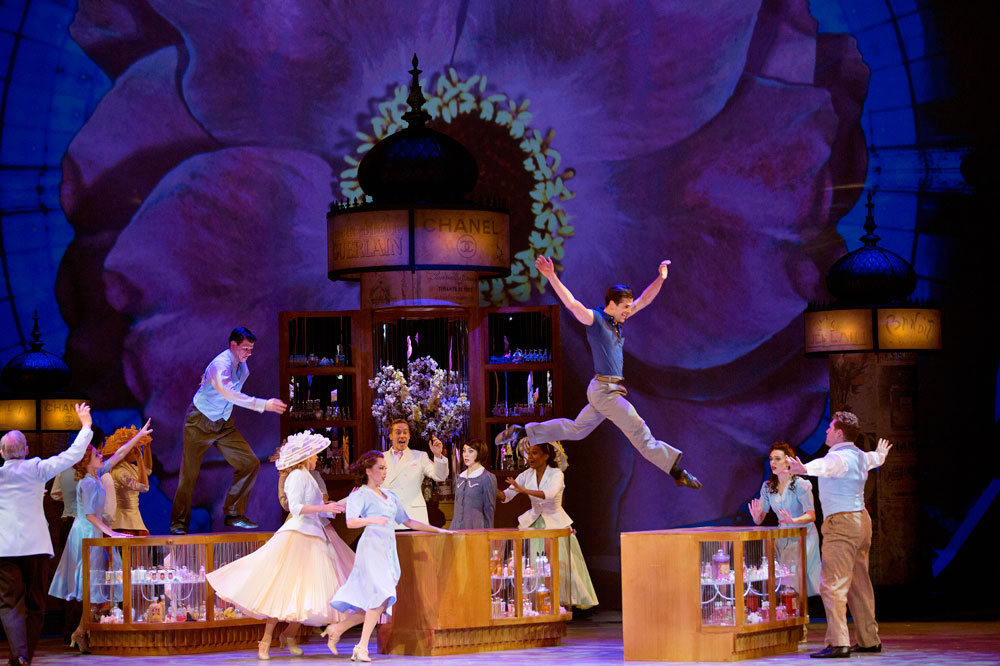
© Angela Sterling. (Click image for larger version)
“There’s quite a lot of fear around ballet on Broadway,” Wheeldon told me. “The movie used the ballet as a kind of fabulous excuse for a big splashy tour around Paris, but I wanted to stay a little closer to the original piece of music. There was some debate about whether we could get away with 12-13 minutes of ballet at the end of a substantial evening of theatre.” The producers needn’t have worried. At a recent preview performance both “Stairway” and Wheeldon’s closing ballet elicited ecstatic reactions. They were enthusiastically received in Paris, too, where American in Paris had its trial run last year. “They just kept clapping, and clapping,” said Jill Paice, who plays the role of Milo, an American heiress who woos Jerry, promising artistic glory as well as a not-unappealing life of good hotels and champagne.
The first act is also propelled by dancing. There is a prologue that amounts to a mini-ballet on themes from the Nazi occupation and liberation of Paris. Unhappy Parisians stomp across the stage and stand in line for food rations. A man lifts a woman into what we suddenly recognize is a swastika shape. A woman walks by, bossily clutching her purse like the office-girl in Jerome Robbins’ “Fancy Free.” (This section is reminiscent of a semi-abstract ballet Wheeldon made for New York City Ballet in 2005, using motifs and music from the film.) Then – surprise! – the German banners fall to the ground and an enormous French flag is unfurled. “Every night, I think of that whole generation who fought the war and get chills,” Robert Fairchild, who plays Jerry Mulligan, said as he prepared for his morning ballet class a few weeks back.
Like his co-star, Leanne Cope, Robert Fairchild is a ballet dancer rather than an experienced musical-theatre man. At New York City Ballet, where he’s a principal, he is considered to be one of the company’s most appealing male dancers and most assured partners. Robbie, as he’s known by everyone, exudes an irrepressible all-American charm. His joy and enthusiasm onstage are infectious. (“I can’t take my eyes off of him!” my date whispered to me in the dark.) Still, he’s mainly a dancer: his singing voice is tuneful but small and his acting effective enough, though he certainly doesn’t steal the show with his thespian skills. He seems perfectly content to be part of the ensemble, reacting, enjoying the repartee. That is, until he starts to dance. As he flies around the stage in a huge circle of jumps, eyes beaming, arms open in a wide embrace, your critical faculties more or less go out the window.

© Angela Sterling. (Click image for larger version)
One of the reasons Wheeldon decided, in the end, to use very little tap, was his desire to allow Fairchild to win the audience over with what he does best, and that is a kind of jazzed-up, un-stuffy version of ballet. Gene Kelly was principally a tapper, Fairchild is not, though he studied tap as a kid. Why tie him down or invite invidious comparisons? Fairchild and Kelly do have certain qualities in common: big expressive eyes, long torsos, muscular legs. “That weight in the way Robbie dances and the jazzy angle of his knees and hips is reminiscent of Kelly,” says Wheeldon. “They share that heavy, masculine and at the same time incredibly nimble and light quality.”
There is a wizened quality to Kelly, though, that Fairchild doesn’t share. Kelly was thirty-nine when he made “American in Paris,” and it shows. His Jerry has a bit of an edge. It’s particularly evident in his relationship with the American heiress, Milo. (He treats her rather shabbily, and you like him less for it.) Robbie is twenty-seven and seems constitutionally incapable of cynicism. Brashness is about as close as he gets. “My Jerry is a little younger, a little fresher,” he says, “after all, it’s five years earlier, just after the war.” You quickly forgive any lack of delicacy on his part.
Similarly, Cope, a dark-haired beauty who dances in the corps at the Royal Ballet, is somewhat more fine-grained than Leslie Caron in the role of Lise, more English Rose than Parisian gamine. (And she has a lovely singing voice.) Upstairs at the Palace theatre between rehearsals, she perches in her tiny dressing room, surrounded by neat rows of freshly-sewn pointe shoes and photos of artists she admires, including one of the great Russian ballerina Anna Pavlova. She is adorable.

© Angela Sterling. (Click image for larger version)
After years of dancing small roles at the Royal she still looks a bit surprised to be a lead in a big Broadway show, opposite a principal dancer from New York City Ballet. She still obsesses a little about the steps. “I always get a bit nervous before the ballet begins,” she says, with a laugh. Every night, the cast gets notes and corrections from Wheeldon, as they would after an evening’s performance at the ballet. “Chris speaks to the dancers a little bit differently,” says Cope, “because, you know, we share a language.”
“An American in Paris” opens officially on Broadway on April 12.














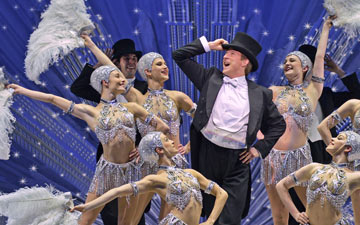
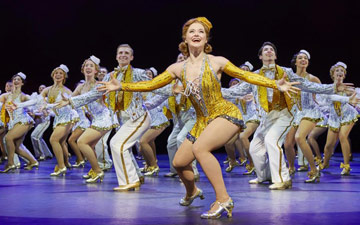

You must be logged in to post a comment.